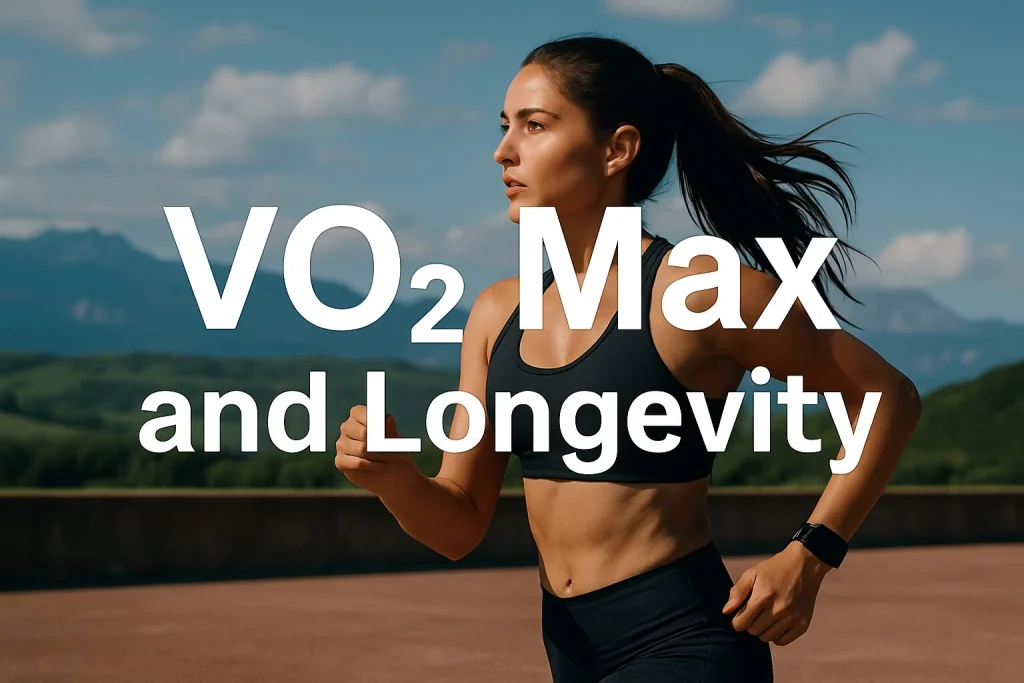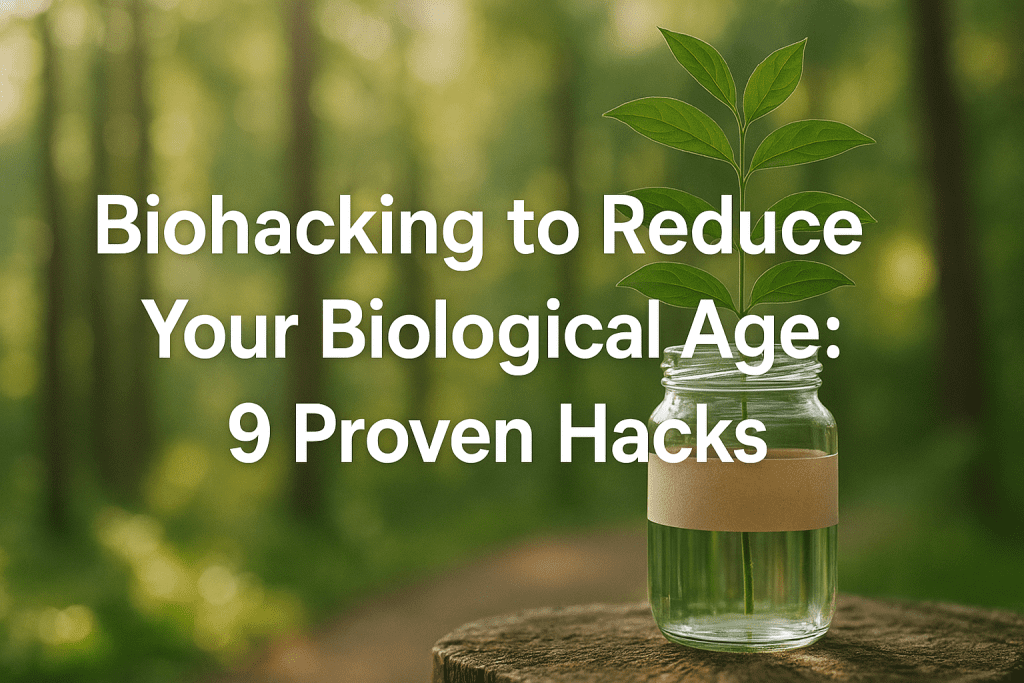
What Is VO₂ Max and Why Is It Important for Longevity?
VO2 Max and longevity are strongly connected.
This measure of how much oxygen your body can use during exercise is one of the most reliable predictors of lifespan. Studies show that higher VO₂ Max levels are linked to lower risk of disease and early death, even more so than blood pressure or cholesterol.
How Does VO₂ Max Affect Biological Aging?
VO₂ Max reflects how efficiently your lungs, heart, and muscles work together. As these systems decline with age, VO₂ Max drops, often by 10% per decade after age 30 unless addressed.
Low VO₂ Max is associated with:
- Increased risk of cardiovascular disease
- Reduced mitochondrial function
- Poor metabolic resilience
- Cognitive decline in aging populations
Maintaining or improving VO₂ Max helps support a slower biological aging process, especially when combined with sleep, nutrition, and recovery habits.
Can You Improve VO₂ Max After 40 or 50?
Yes, and faster than you might think. Studies show that targeted interventions — even modest ones — can meaningfully raise VO₂ Max at any age. Improvements of just 3–5 mL/kg/min are linked to 10–20% lower mortality risk Study: NIH
🧬 In simple terms: every gain in VO₂ Max helps extend both lifespan and healthspan.
What Are the Best Ways to Improve VO2 Max?
Here are five science-backed strategies, no gym membership required.
⚡High-Intensity Interval Training (HIIT)
Fast, effective gains through short bursts of effort and rest.
✔ What it is: 20 to 60 seconds intense effort plus 1 to 2 minutes of active rest
✔ Why it works: Forces your heart and lungs to adapt quickly
✔ Try this: 30-second sprint and 90-second walk, repeated 4 to 6 times
🏃Endurance Training
Cardio builds a durable aerobic engine for VO₂ Max.
✔ What it is: Running, swimming, cycling, or rowing
✔ Why it works: Improves oxygen delivery to muscles over time
✔ Try this: 150 to 300 minutes per week of moderate to vigorous activity
🏋️Strength Training
Stronger muscles improve your body’s ability to use oxygen efficiently during higher effort.
✔ What it is: Full-body workouts using weights or bodyweight
✔ Why it works: Supports high-intensity performance and muscular oxygen use
✔ Try this: 2 to 3 sessions per week focused on compound lifts
✔ Bonus: Reduces the workload on your heart during effort
🌬️Breath Training
Improves respiratory efficiency and reduces fatigue under pressure.
✔ What it is: Diaphragmatic breathing or inspiratory muscle training (IMT)
✔ Why it works: Trains the respiratory muscles and increases oxygen intake
✔ Try this: 10 to 15 minutes of deep nasal breathing daily
🛌Recovery, Sleep & Lifestyle
Your VO₂ Max gains happen during recovery, not just during training. Lifestyle factors support that process.
✔ Key habits: 7 to 9 hours of sleep, manage stress, reduce inflammation through diet
✔ Why it works: Supports cardiovascular adaptation and mitochondrial repair
✔ Nutrition: Prioritize omega-3s, leafy greens, and consistent mealtimes
Even Small VO₂ Max Gains = Big Health Benefits
- A VO₂ Max increase of just 3.5 mL/kg/min is associated with a 15% reduction in early death risk.
- Older adults who improve VO₂ Max through walking or cycling experience better memory, mobility, and immune response.
💡 Aging is inevitable: but how fast you age is not. And VO₂ Max gives you a lever to slow it down.
VO2 Max Charts for Men and Women
Below are the age‑ and gender‑specific VO₂ Max charts for men and women, detailing Poor, Fair, Good, Excellent, and Superior percentile thresholds to help you benchmark your aerobic fitness.
Men – VO2 Max Chart by Age
| Age | Poor (<40th) | Fair (40th) | Good (60th) | Excellent (80th) | Superior (95th) |
|---|---|---|---|---|---|
| 20-29 | <41.7 | 41.7 | 45.4 | 51.1 | 55.4 |
| 30-39 | <40.5 | 40.5 | 44.0 | 48.3 | 54.0 |
| 40-49 | <38.5 | 38.5 | 42.4 | 46.4 | 52.5 |
| 50-59 | <35.6 | 35.6 | 39.2 | 43.4 | 48.9 |
| 60-69 | <32.3 | 32.3 | 35.5 | 39.5 | 45.7 |
| 70-79 | <29.4 | 29.4 | 32.3 | 36.7 | 42.1 |
Women – VO2 Max Chart by Age
| Age | Poor (<40th) | Fair (40th) | Good (60th) | Excellent (80th) | Superior (95th) |
|---|---|---|---|---|---|
| 20-29 | <36.1 | 36.1 | 39.5 | 43.9 | 49.6 |
| 30-39 | <34.4 | 34.4 | 37.8 | 42.4 | 47.4 |
| 40-49 | <33.0 | 33.0 | 36.3 | 39.7 | 45.3 |
| 50-59 | <30.1 | 30.1 | 33.0 | 36.7 | 41.1 |
| 60-69 | <27.5 | 27.5 | 30.0 | 33.0 | 37.8 |
| 70-79 | <25.9 | 25.9 | 28.1 | 30.9 | 36.7 |
Frequently Asked Questions (FAQ)
What is a good VO₂ Max by age?
VO₂ Max varies by age and gender. For example, 40 mL/kg/min is excellent for a healthy 30-year-old male. After 50, maintaining 30+ is a strong longevity marker.
How fast can you improve VO₂ Max?
Noticeable improvements can occur in just 4–6 weeks with consistent HIIT or endurance training.
Do wearable trackers give accurate VO₂ Max estimates?
They offer general estimates, but clinical-grade tests or sports labs provide more reliable data.
Is VO₂ Max more important than heart rate?
Yes. Resting heart rate is helpful, but VO₂ Max reflects total cardiorespiratory capacity, making it a better predictor of performance and mortality risk.
Can walking improve VO₂ Max?
Yes, especially brisk walking uphill or with intervals. Any aerobic movement that raises your heart rate helps.
Is VO₂ Max testing expensive?
Lab tests can cost $100–$300. But wearable devices or smart treadmills provide free approximations suitable for most users.
What’s the best supplement for improving VO₂ Max?
Beetroot juice (rich in nitrates) and creatine show promise, but lifestyle remains more impactful than supplements.
Is VO₂ Max linked to cognitive decline or dementia?
Yes. Several studies associate higher VO₂ Max with lower dementia risk and better executive function in older adults.
Sources:
- American Heart Association – VO2 Max: What It Is and How to Improve It
- NIH / National Library of Medicine – Cardiorespiratory Fitness as a Predictor of Mortality (2020)
- Harvard Health Publishing – VO2 max: What is it and how can you improve it? (2022)
Related Reading on Simply Anti-Aging
- The Ultimate Biological Age Test Kit Comparison 2025
- Honey Anti-Aging Superfood: Real Benefits for Skin & Body
Created by SimplyAntiAging.com’s Editorial Research Team
Reviewed and updated for accuracy in December 2025.



